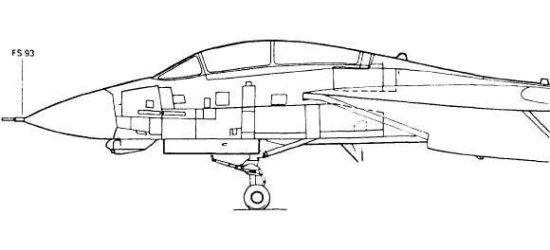|
||||||||||
|
|
||||||||||
|
||||||||||
|
|
||||||||||

The above example shows the FS, WL, BL station coordinate system for the F-14 Tomcat. The distances shown are in inches since this is the typical unit used for aircraft design drawings in the US. For this particular plane, the origin of the longitudinal FS coordinate is 93 inches ahead of the nose, not counting the long pitot tube only present on some flight test aircraft. The origin of the vertical WL coordinate is about 60 inches below the landing gear while the lateral BL coordinate begins at the centerline.
There is no one accepted method for locating this origin. The choice of location is up to each individual designer. The butt line coordinate is almost universally placed at the centerline of the aircraft since this axis defines a plane of symmetry for most planes. Some designers do choose to place the fuselage station and/or the water line at the nose as the questioners suggest. The water line coordinate is also sometimes started at the static ground line.
In many cases, however, both the FS and WL station are started some distance away from the aircraft. The reason for this choice is probably because it is common for an aircraft to grow, shrink, or otherwise change during the design process. A fixed coordinate system is desirable because key structural and other components are frequently identified by their position, such as a "FS 500 bulkhead" for example. As a design changes, it is very possible for the plane's nose to move forward while the wings and aft fuselage maintain the same position in the station coordinate system. In so doing, the tip of the nose could move so far forward that it has a negative FS position. While there is nothing necessarily wrong with negative FS coordinates, it is generally easier to work in a system where all all coordinates are positive. Designers therefore often choose to place the origin of the coordinate system far enough forward and below the aircraft that the FS and WL coordinates will remain positive even as the design is enlarged.

In summary, the most common practices I have seen in placing the origin of the coordinate system are:
The station coordinates are not only important during the initial design process but are also used throughout a
vehicle's life. Operational manuals often specify locations for attaching weapons or fuel tanks in FS/BL/WL
positions. The system is also used for maintenance and upgrade procedures when the locations of replacement parts
are specified in station coordinates.
- answer by Jeff Scott, 14 January 2007
Read More Articles:


|
Aircraft | Design | Ask Us | Shop | Search |

|
|
| About Us | Contact Us | Copyright © 1997-2023 | |||
|
|
|||